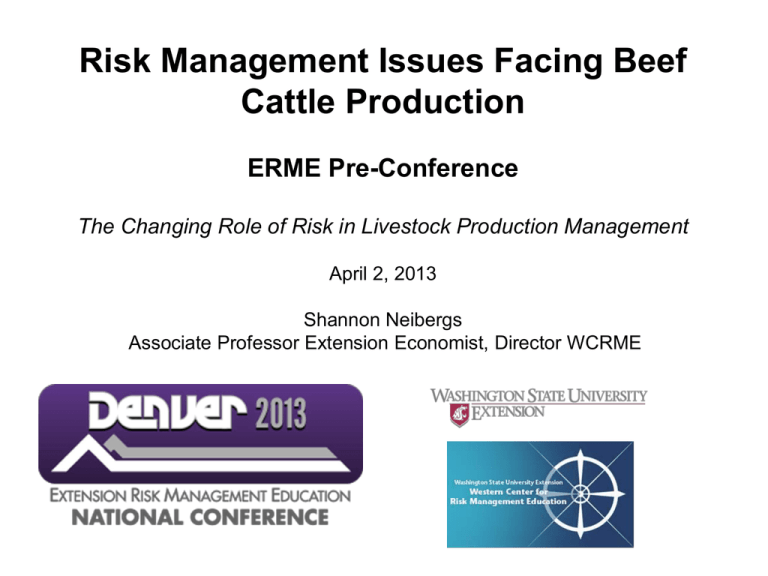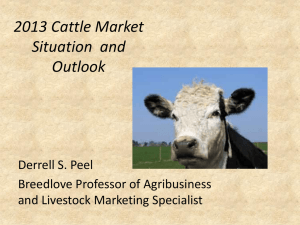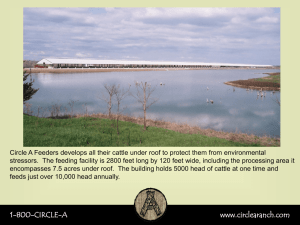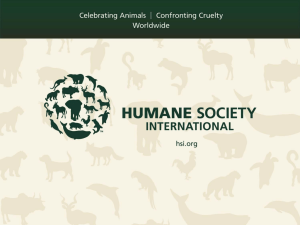Risk Management Issues Facing Beef Cattle Production
advertisement

Risk Management Issues Facing Beef Cattle Production ERME Pre-Conference The Changing Role of Risk in Livestock Production Management April 2, 2013 Shannon Neibergs Associate Professor Extension Economist, Director WCRME Overview of Presentation • Price variability and market risk in beef markets • Cattle risk management options • Production management risk issues • Feed additives - Ractopamine • New management tools Monthly Meat Price Spreads http://www.ers.usda.gov/data-products/meat-price-spreads.aspx Beef Price Spread Analysis • • • • • • • • Net Farm Value share of retail value increasing since 2010 Derived demand market is driven by the consumer (domestic and export) Beef demand continues to struggle in the start of 2013 First quarter beef production is lowest since 2006 down 3% from 2012 Beef production down due to decreased slaughter numbers – carcass weight increasing Composite cut-out value has an apparent price ceiling at $200 cwt Fed cattle trading to trend below $130 cwt Substitution effects between protein products limits price gains Meat in cold storage is relatively high Source: DLR Vol. 11, No. 16 / January 23, 2013 Beef export trends U S BEEF EXPORTS TO MAJOR MARKETS Carcass Weight, Monthly Mil. Pounds 90 80 Japan 70 60 Canada 50 40 30 Mexico 20 10 0 2005 2006 2007 2008 Livestock Marketing Information Center Data Source: USDA-ERS & USDA-FAS 2009 2010 2011 2012 2013 I-N-35 03/11/13 South Korea Cattle on Feed Profitability AVERAGE RETURNS TO CATTLE FEEDERS Feeding 725 Lb. Steers, S. Plains, Monthly $ Per Head 275 225 175 125 75 25 -25 -75 -125 -175 -225 -275 -325 2004 2005 2006 2007 2008 2009 Livestock Marketing Information Center Data Source: USDA-AMS & USDA-NASS, Compiled & Analysis by LMIC 2010 2011 2012 2013 C-P-22 03/15/13 Negative profit pressure on feeder prices MED. & LRG. #1 FEEDER STEER PRICES 700-800 Pounds, Southern Plains, Weekly $ Per Cwt. 170 160 Avg. 2007-11 150 140 130 2012 120 110 2013 100 90 JAN APR Livestock Marketing Information Center Data Source: USDA-AMS, Compiled & Analysis by LMIC JUL OCT C-P-49 03/25/13 And calf price MED. & LRG. #1 STEER CALF PRICES 400-500 Pounds, Southern Plains, Weekly $ Per Cwt. 235 Avg. 2007-11 215 195 175 2012 155 135 2013 115 JAN APR Livestock Marketing Information Center Data Source: USDA-AMS, Compiled & Analysis by LMIC JUL OCT C-P-49A 03/25/13 Cow – calf returns COW-CALF RETURNS AND CATTLE INVENTORY $ Per Cow 180 U.S., Annual Mil. Head 120 140 115 100 110 60 105 20 100 -20 95 -60 90 -100 Cow-Calf Returns Cattle Inventory Jan 1 85 1984 1986 1988 1990 1992 1994 1996 1998 2000 2002 2004 2006 2008 2010 2012 Livestock Marketing Information Center Data Source: USDA-AMS & USDA-NASS, Compiled & Analysis by LMIC C-P-67 12/18/12 Cattle on Feed – will declining supply drive price? CATTLE ON FEED US Total, Monthly Mil. Head 12.0 Avg. 2007/11 11.5 11.0 2012 10.5 2013 10.0 9.5 JAN FEB MAR APR MAY Livestock Marketing Information Center Data Source: USDA-NASS JUN JUL AUG SEP OCT NOV DEC C-N-10 03/22/13 Cattle Risk Management Options Cow-Calf Market Risk Favorable calf prices have eased market risk management for cow-calf producers – given adequate forage availability. Market Risk Management Options 1. Forward Contract • • Direct to feedlot Backgrounding operation 2. Hedging – risk transfer a. Offset futures market contract transaction with local cash market b. Futures Market • Feeder Cattle Contract 50,000 lbs, 650-849 lbs • Live (Fed) Contract 40,000 lbs, 55% Choice, YG 3 c. Options Market • Put and call collar strategy Basis – Price difference between Chicago and Toppenish 428 S. G Street Toppenish WA 98948 Market Risk Management - Basis www.BeefBasis.com BeefBasis.com current hedge analysis Market Risk Management Options 3. LRP (Livestock Risk Protection) insurance is an USDA RMA insurance policy intended to provide protection against a price decrease for feeder and fed cattle. • If the Actual Ending Value is below the Expected “Insured” Ending Value a loss may be paid relative to the Producer’s chosen coverage level. LRP Parameters To Execute a LRP insurance policy When purchasing an Specific Coverage Endorsement (SCE) through an insurance agent (http://www3.rma.usda.gov/tools/agents/companies/indexLPI.cfm) Producer Determines: Number of head to insure Date and weight expects to market livestock Producer Selects: Coverage price Endorsement length Producer Pays premium: Endorsement in effect upon receipt of RMA approval number LRP Purchase Coverage Prices, Rates http://www3.rma.usda.gov/apps/livestock_reports/main.aspx LRP Actual Value Feeder Cattle Price Index http://www.cmegroup.com/market-data/datamine-historical-data/cash-settled-commodity-index-prices.html LRP Coverage Prices, Rates and Actual Ending Values http://www3.rma.usda.gov/apps/livestock_reports/main.aspx RLRP Coverage Prices, Rates and Actual Ending Values Risk Averse Scenario - choosing highest coverage available Endorsement Length 13 weeks Notes Expected end value $159.739 From RMA Table Coverage Level 0.9629 Producer Choosen Coverage Price $153.813 From RMA Table Cost / cwt $2.644 From RMA Table Assume 100 600 lb Feeders 600 Cwt insured Insured Value $92,288 Insure coverage price Premium Payment $1,586 Cost * insured weight Subsidy 13% $206 13% subsidy Net Premium Payment $1,380 Net premium payment Actual End Value $138.83 CME price index Indemnity Payment $8,989.61 (Coverage-end)*cwts Gain/(loss) in expected market value ($12,545.40) ROUGH estimate of market loss Gain/(loss) in LRP investiment ROI on LRP $7,609.44 Indemity - net premium payment 551% Gain / net premium payment Market Risk Management Options 3. LGM Cattle (Livestock Gross Margin Cattle) insurance is an USDA RMA insurance policy intended to provide gross margin protection between fed cattle price and (cattle feeder cost and feed cost). LGM Cattle LGM for Cattle is different from traditional options in that LGM for Cattle is a bundled option that covers both the cost of feeder cattle and the cost of feed. This bundle of options effectively insures the producer’s gross margin (cattle price minus feeder cattle and feed costs) over the insurance period. Indemnity at end of 11-month insurance period is the difference, if positive, between gross margin guarantee and actual gross margin Does not insure against loss due to death or damage to cattle LGM Cattle Expected/Actual gross margin per head of cattle for a yearling finishing operation = (12.50 * Live Cattlet) – (7.50 * Feeder Cattlet-5) – (50 * Cornt-2) Gross Margin Guarantee = Expected gross margin – deductible Deductibles from $0 to $150 per head The premium is calculated by a determinant Monte Carlo simulation procedure Indemnity payment = Gross margin guarantee – actual gross margin if greater than zero U.S. LRP and LGM Summery of Use LRP and LGM Policies and Loss Ratios Number Number Policies Earning Policies Earning Premium Indemnity Loss Ratio LRP LGM LRP LGM LRP LGM 2008 715 32 500 22 1.62 1.30 2009 410 21 242 8 1.60 0.37 2010 803 9 441 0 0.48 0.00 2011 1460 8 447 2 0.16 0.10 2012 1228 2 669 1 1.15 1.58 Federal Crop Insurance Corp. Summary of Business - Livestock as of 03/28/2013 http://www3.rma.usda.gov/apps/sob/soblpi/commodity.cfm 2012 LRP by State Use 2012 By State LRP Feeder Cattle Summary of Business and Loss Ratios State ALABAMA ARKANSAS CALIFORNIA COLORADO GEORGIA IOWA IDAHO ILLINOIS INDIANA KANSAS KENTUCKY MICHIGAN MINNESOTA MISSOURI MISSISSIPPI MONTANA NORTH CAROLINA NORTH DAKOTA NEBRASKA NEW MEXICO OHIO OKLAHOMA OREGON SOUTH DAKOTA TENNESSEE TEXAS VIRGINIA WASHINGTON WISCONSIN WEST VIRGINIA WYOMING Policies Policy Number Avg head Total Earn Prem Indemnity of Head policy Liabilities Premium Subsidy Indemnity 2 2 50 25 43,417 1,272 164 2,862 2 1 157 79 162,756 1,591 207 7,530 0 0 0 0 0 0 0 0 22 5 2,416 110 2,502,953 55,826 7,256 28,313 2 2 346 173 373,240 11,716 1,523 27,302 29 15 4,839 167 5,027,134 119,003 15,471 177,078 12 5 1,006 84 1,046,433 27,950 3,635 32,099 1 1 7 7 5,986 91 12 162 3 2 340 113 357,539 7,049 917 3,182 157 96 24,199 154 23,766,208 434,697 56,523 684,973 9 5 911 101 908,370 12,388 1,610 21,152 0 0 0 0 0 0 0 0 14 7 1,305 93 1,508,524 36,715 4,774 17,302 47 27 9,716 207 10,373,453 227,288 29,550 382,629 1 1 75 75 69,774 2,570 334 2,298 34 26 5,005 147 4,997,361 161,322 20,973 266,565 0 0 0 0 0 0 0 0 126 68 15,745 125 17,722,975 381,829 49,634 687,019 231 136 27,202 118 27,122,685 773,296 100,527 976,992 2 1 2,180 1090 2,850,892 94,867 12,332 98,814 0 0 0 0 0 0 0 0 87 33 25,743 296 27,217,127 467,110 60,724 425,890 11 8 2,267 206 2,751,545 79,886 10,384 95,394 278 133 40,855 147 41,475,990 1,278,042 166,138 1,046,667 21 12 3,884 185 4,095,138 43,029 5,594 29,647 8 5 1,608 201 1,603,665 22,698 2,951 30,420 23 17 1,843 80 1,984,994 40,916 5,319 95,248 10 9 580 58 592,993 24,283 3,157 44,078 5 3 253 51 275,398 6,970 906 1,069 20 5 1,569 78 1,736,826 33,933 4,415 21,927 17 11 2,944 173 3,481,959 98,369 12,787 181,760 Federal Crop Insurance Corp. Summary of Business - Livestock as of 03/28/2013 http://www3.rma.usda.gov/apps/sob/soblpi/commodity.cfm Loss Ratio 2.25 4.73 0 0.51 2.33 1.49 1.15 1.78 0.45 1.58 1.71 0 0.47 1.68 0.89 1.65 0 1.8 1.26 1.04 0 0.91 1.19 0.82 0.69 1.34 2.33 1.82 0.15 0.65 1.85 AGR – Lite Revenue Insurance Adjusted Gross Revenue (AGR) –Lite is a whole-farm/ranch revenue protection plan of insurance. • • • Uses a Producer’s 5 year historical farm average revenue as reported to IRS on Schedule F. Provides insurance for multiple commodities in one insurance product. Widely available (WA, ID, OR and several others). Revenue Premium Coverage Subsidy Levels 48% 80% 55% 75% 59% 65% • Subsidized premium: • Insurance based on revenue but Schedule F expenses are reviewed. • March 15 purchase deadline. Market Risk No matter what market risk tool you chose to use, you still need to market the cattle and deliver them to a sale point. http://texashistory.unt.edu/ark:/67531/metapth43358/ Production Management Risk – Feed additive Change in beef production management due to ractopamine hydrochloride • • • • Very effective feed additive to promote lean muscle growth FDA approved and commercially available since 2004 Optaflex and Zilmax for beef, Paylean for swine Partitions nutrients from fat growth to lean growth through increased protein synthesis • Trials show 17 to 21 lbs increased gain and increased dressing percent with limited impact on quality grade Production Management Risk – Feed additive Impacts in beef production management due to ractopamine hydrochloride • Cattle can be placed in feedlots heavier but are on feed relatively longer to increase lean carcass weight • Packaging issues • • • • Larger rib eyes increases ability for thin cut steaks and maintain adequate portion size Traditional grilling steaks are larger and priced on weight are expensive Changing how families eat steak as they are passed around the dinner table, or will consumers accept steaks cut in half Increased size of roasts are not as much an issue and increased trim is beneficial in the hamburger production chain Production Management Risk – Feed additive Market risk due to ractopamine hydrochloride • FDA approval does not ensure consumer acceptance • • bST and fluid milk Ammonium hydroxide treatment of Lean Finely Textured Beef • Trade restrictions on ractopamine • • • • Russia, China, European Union Separate production / processing systems if packer wants to serve those markets • Differential demand across the carcass cuts Agreeing to ship ractopamine free pork and beef to these markets could lead other countries to introduce similar restrictions If producers stop using ractopamine at a time of record-high feed prices, they will see their losses increase Production Management Risk – Marker assisted selection Examples of genetic markers under investigation • • • • • Disease susceptibility to BRD Feed efficiency Meat quality Grazing tendency Reproductive efficiency • Marker assisted selection • • Marker assisted selection effective for individual trait phenotypes Work needed on determining the co-variance between genetic markers • Positively or negatively correlated • Heritability of traits • Economic importance • Marker assisted selection implemented at cow-calf level • Extract market value of improved genetics at weaning • Value of preconditioned calves • Retained ownership Summary and Questions Thank you Shannon Neibergs sneibergs@wsu.edu 509 335 6360








